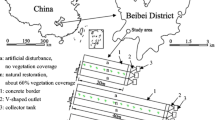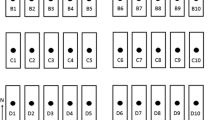Abstract
In this study, multi-year stormflow data collected at both catchment and plot scales on an event basis were used to evaluate the efficiency of conservation. At the catchment scale, soil loss from YDG, an agricultural catchment with no conservation measures, was compared with that from CZG, an agricultural catchment with an implementation of a range of conservation measures. With an increase of storm recurrence intervals in the order of <1, 1–2, 2–5, 5–10, 10–20, and >20 years, the mean event sediment yield was 639, 1721, 5779, 15191, 19627, and 47924 t/km2 in YDG, and was 244, 767, 3077, 4679, 8388, and 15868 t/km2 in CZG, which represented a reduction effectiveness of 61.8, 55.4, 46.7, 69.2, 57.2, and 66.8 %, respectively. Storm events with recurrence intervals greater than 2 years contributed about two-thirds of the total runoff and sediment in both YDG and CZG catchments. At the plot scale, soil loss from one cultivated slopeland was compared with that from five conservation plots. The mean event soil loss was 1622 t/km2 on the cultivated slopeland, in comparison to 27.7 t/km2 on the woodland plot, 213 t/km2 on the grassland plot, 467 t/km2 on the alfalfa plot, 236 t/km2 on the terraceland plot, and 642 t/km2 on the earthbank plot. Soil loss per unit area from all the plots was significantly less than that from the catchments for storms of all categories of recurrence intervals.










Similar content being viewed by others
References
Alimohammadlou Y, Najafi A, Gokceoglu C (2014) Estimation of rainfall-induced landslides using ANN and fuzzy clustering methods: a case study in Saeen Slope, Azerbaijan province, Iran. Catena 120:149–162
Bagarello V, Di Stefano C, Ferro V, Pampalone V (2011) Using plot soil loss distribution for soil conservation design. Catena 86(3):172–177
Baker VR (1977) Stream-channel response to floods, with examples from central Texas. Geol Soc Am Bull 88(8):1057–1071
Bautista S, Mayor AG, Bourakhouadar J, Bellot J (2007) Plant spatial pattern predicts hillslope runoff and erosion in a semiarid Mediterranean landscape. Ecosystems 10:987–998
Belmonte M, Beltrán F (2001) Flood events in Mediterranean ephemeral streams (ramblas) in Valencia region, Spain. Catena 45:229–249
Casermeiro MA, Molina JA, de la Cruz Caravaca MT, Hernando Costa J, Hernando Massanet MI, Moreno PS (2004) Influence of scrubs on runoff and sediment loss in soils of Mediterranean climate. Catena 57:91–107
Chirino E, Bonet A, Bellot J, Sánchez JR (2006) Effects of 30-year-old Aleppo pine plantations on runoff, soil erosion, and plant diversity in a semi-arid landscape in south eastern Spain. Catena 65:19–29
Cooke RU, Doornkamp JC (1990) Geomorphology in environmental management. Clarendon Press, Oxford
Diodato N (2006) Modelling net erosion responses to enviroclimatic changes recorded upon multisecular timescales. Geomorphology 80:164–177
Douglas I (1989) Land degradation, soil conservation and the sediment load of the Yellow River, China: review and assessment. Land Degrad Dev 1:141–151
Edwards WM, Owens LB (1991) Large storm effects on total soil erosion. J Soil Water Conserv 46(1):75–78
FAO (1981) Arid zone hydrology, FAO Irrigation and Drainage Paper 37. Food and Agricultural Organization of the United Nations, Rome, Italy
FAO (1987) Soil and water conservation in semi-arid areas. FAO Soils Bulletin 57
Garcia-Estringana P, Alonso-Blázquez N, Marques MJ, Bienes R, González-Andrés F, Alegre J (2013) Use of Mediterranean legume shrubs to control soil erosion and runoff in central Spain. A large-plot assessment under natural rainfall conducted during the stages of shrub establishment and subsequent colonisation. Catena 102:3–12
Gonzalez-Hidalgo JC, de Luis M, Peña JL (2007) A review of daily soil erosion in western Mediterranean areas. Catena 71:193–199
Gupta A (1995) Magnitude, frequency, and special factors affecting channel form and processes in the seasonal tropics. In: Natural and anthropogenic influences in fluvial geomorphology. pp 125–136
Heede BH (1974) Stages of development of gullies in Western United States of America. Z Geomorphol N F 18(3):260–271
Heritage GL, Large ARG, Moon BP, Jewitt G (2004) Channel hydraulics and geomorphic effects of an extreme flood event on the Sabie River, South Africa. Catena 58:151–181
Hernandez M, Goodrich D, Goff D, Kepner W, Edmonds C, Jones K (2000) Modeling runoff response to land cover and rainfall spatial variability in semi-arid watersheds. Environ Monit Assess 64:285–298
Lal R (1998) Soil erosion impact on agronomic productivity and environment quality. Crit Rev Plant Sci 17:319–464
Lal R (2001) Soil degradation by erosion. Land Degrad Dev 12:519–539
Larson WE, Lindstrom MJ, Schumacher TE (1997) The role of severe storms in soil erosion: a problem needing consideration. J Soil Water Conserv 50:90–95
Liu BY, Nearing MA, Risse LM (1994) Slope gradient effects on soil loss from steep slopes. Trans ASAE 37(6):1835–1840
Liu BY, Nearing MA, Shi PJ, Jia ZW (2000) Slope length effects on soil loss for steep slopes. Soil Sci Soc Am J 64:1759–1763
Liu DS (1964) Loess Deposits in the Middle Reaches of Yellow River. Science Press, Beijing, p 234 (in Chinese)
Maestre FT, Bautista S, Cortina J, Bellot J (2001) Potential for using facilitation by grasses to establish shrubs on a semiarid degraded steppe. Ecol Appl 11:1641–1655
Mannaerts CM, Gabriels D (2000) A probabilistic approach for predicting rainfall soil erosion losses in semiarid areas. Catena 40(4):403–420
McBroom M, Beasley RS, Chang M, Gowin B, Ice G (2003) Runoff and sediment losses from annual and unusual storm events from the alto experimental watersheds, Texas: 23 years after silvicultural treatments. In: Proceedings of First Interagency Conference on Research in the Watersheds, Benson, AZ
Nash DB (1994) Effective sediment-transporting discharge from magnitude-frequency analysis. J Geol 102:79–95
Ngetich KF, Diels J, Shisanya CA, Mugwe JN, Mucheru-muna M, Mugendi DN (2014) Effects of selected soil and water conservation techniques on runoff, sediment yield and maize productivity under sub-humid and semi-arid conditions in Kenya. Catena 121:288–296
Nolan KM, Kelsey HM (1987) Bankfull discharge and sediment transport in northwestern California. International Association of Hydrological Sciences 165:439–449
Osborn HB, Hickok RB (1968) Variability of rainfall affecting runoff from a semiarid rangeland watershed. Water Resour Res 4:199–203
Osterkamp WR, Friedman JM (2000) The disparity between extreme rainfall events and rare floods—with emphasis on the semi-arid American West. Hydrol Process 14:2819–2829
Poesen J, Vandekerckhove L, Nachtergaele J, Oostwoud Wijdenes D, Verstraeten G, van Wesemael B (2002) Gully erosion in dryland environments. In: Bull LJ, Kirkby MJ (eds) Dryland rivers: hydrology and geomorphology of semi-arid channels. Wiley, Chichester, pp 229–262
Poesen J, Nachtergaele J, Verstraeten G, Valention C (2003) Gully erosion and environmental change: importance and research needs. Catena 50:91–133
Sutherland RA (1998a) Rolled erosion control systems for hillslope surface protection: a critical review, synthesis and analysis of available data. I. Background and formative years. Land Degrad Dev 9:465–486
Sutherland RA (1998b) Rolled erosion control systems for hillslope surface protection: a critical review, synthesis and analysis of available data. II. The post-1990 period. Land Degrad Dev 9:487–511
Webb BW, Walling DE (1982) The magnitude and frequency characteristics of fluvial transport in a Devon drainage basin and some geomorphological implications. Catena 9(1):9–23
Wei W, Chen L, Fu B, Huang Z, Wu D, Gui L (2007) The effect of land uses and rainfall regimes on runoff and soil erosion in the semi-arid loess hilly area, China. J Hydrol 335:247–258
White S, Garcia-Ruiz JM (1998) Extreme erosional events and their role in mountain areas of northern Spain. Ambio 27(4):300–305
Wolman MG, Miller JP (1960) Magnitude and frequency of forces in geomorphic processes. J Geol 68(1):54–74
Zeng BQ (1983) Methods for soil and water loss monitoring in the small catchment. Soil Water Conserv Shanxi 2:11–19 (in Chinese)
Zhu TX (1997) Deep-seated, complex tunnel systems—a hydrological study in a semi-arid catchment, Loess Plateau, China. Geomorphology 20:255–267
Zhu TX (2012) Gully and tunnel erosion in the hilly loess region on the Loess Plateau of China. Geomorphology 153:144–155
Zhu TX, Cai QG, Zeng BQ (1997) Runoff generation in a semi-arid agricultural catchment: field and experimental studies. J Hydrol 196:99–118
Zhu TX, Luk SH, Cai QG (2002) Tunnel erosion and sediment production in the hilly loess region, North China. J Hydrol 257:78–90
Zhu AX, Wang P, Zhu TX, Chen LJ, Cai QG, Liu HP (2013) Modeling runoff and soil erosion in the Three-Gorge Reservoir drainage area of China using limited plot data. J Hydrol 492:163–175
Acknowledgments
This project was supported by a grant-in-aid provided by the Graduate School, University of Minnesota (Grant No. 22166) and funds from the Shanxi Bureau of Soil and Water Conservation as well as from the Shanxi Bureau of Sciences and Technology. Rainfall, soil loss, and runoff data were provided by the Shanxi Institute of Soil and Water Conservation.
Author information
Authors and Affiliations
Corresponding author
Rights and permissions
About this article
Cite this article
Zhu, T.X. Effectiveness of Conservation Measures in Reducing Runoff and Soil Loss Under Different Magnitude–Frequency Storms at Plot and Catchment Scales in the Semi-arid Agricultural Landscape. Environmental Management 57, 671–682 (2016). https://doi.org/10.1007/s00267-015-0644-4
Received:
Accepted:
Published:
Issue Date:
DOI: https://doi.org/10.1007/s00267-015-0644-4




